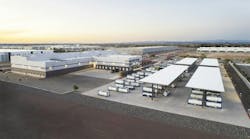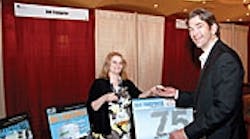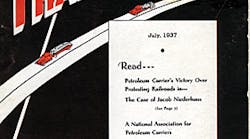John Conley penned his last editorial as editor of Modern Bulk Transporter in the October issue, but we have been able to coax numerous guest editorials from him over the past 23 years. He has been a friend and great help to all of us at the magazine as we worked hard to cover a very complex industry. John set a high bar for editorial quality, and the learning curve was steep.
November 1989 — Reports broke in the general news media during the summer that the same tank trailers were being used to haul food products and dangerous chemicals. Congress wasted no time weighing in on the issue. They held a lot of hearings, took a lot of testimony, and proposed legislation. The biggest challenge was deciding which federal agency would actually write regulations to cover tank trailers that haul food.
December 1989 — Five companies cooperated in the development of the innovative Freightliner/Heil Advanced Concept Truck (FACT) that was introduced at the Society of Automotive Engineers (SAE) Truck and Bus Meeting. Partners included Freightliner Corp, Heil Company, Shell Oil Company, Rohm and Haas, and Michelin Tire Co.
A primary goal in designing the FACT unit was reduction of potential for rollovers and product spills. An offshoot of another program at Freightliner parent company Daimler, the FACT rig incorporated new features to enhance truck stability, braking, handling, and crashworthiness. The six-axle tractor-trailer rig was designed for a gross combination weight of 88,000 pounds.
An SAE study presented at the meeting stated that more than 80% of major leaks in bulk tank accidents resulted from rollovers. Puncture of the tank shell was the major cause of leaks in a rollover.
The 1990s
January 1990 — The editorial in this issue of Modern Bulk Transporter declared that the 1990s would be the decade of re-regulation for the tank truck industry. While HM183 and all of its elements was one reason, another factor was HM181, which would adopt performance-oriented packaging standards developed by the United Nations.
February 1990 — Trimac Transportation System purchased Ryder Bulk Transportation Services Inc. The acquisition included 158 power units, 218 trailers, and 10 terminals.
September 1990 — Diesel fuel prices increased 20% to 40% across the United States following Iraq's invasion of Kuwait. The average price across the country was $1.41 a gallon according to the Interstate Commerce Commission, and many tank truck fleets were struggling to collect surcharges to cover the increase. Some fleet executives predicted diesel prices as high as $2 a gallon if the United States sent troops to the Middle East.
October 1990 — The Department of Transportation sent Congress a proposal for legislation that would require hazmat transporters to pay a yearly fee, not to exceed $100, to fund emergency response training for state emergency responders.
December 1990 — The Hazardous Materials Transportation Uniform Safety Act of 1990 was signed by President George H W Bush, and the hazmat carrier registration fee was now a reality. However, the amount had grown considerably to $250 to $1,000 per company.
President Bush also signed the Safe Food Transport Law, which called for more oversight of foodgrade shipments.
Alaska-West Express unveiled a new state-of-the-art transload facility in Fairbanks, Alaska. The facility included an 80-ft truck scale built over a concrete containment pit that can hold more than 36,000 gallons of product in the event of a spill, fiberglass spill pans under the track, and high-speed pumps that can transfer chemicals and other products at a rate of up to 500 gallons per minute. Transloading operations continued to grow in size and sophistication throughout the 1990s.
May 1991 — Robert J Schaupp, president of LCL Transit Co and 1990-1991 NTTC chairman, said that despite high fuel prices some tank truck carries felt 1990 had been one of their best years. The most upbeat carriers were the ones that had been able to pass along fuel surcharges to customers.
ISO 9000, an international quality standard that had gained wide acceptance in western Europe, was a big topic at the third annual Tank Container USA conference. US tank fleets were cautioned to be prepared for ISO 9000 because US chemical companies were almost certain to require carrier participation.
June 1992 — Significant progress had been made on a proposed tank cleaning facility audit form, committee members said during the NTTC Tank Cleaning Council's third annual seminar. The audit form was completed in July and remains in use today.
November 1992 — The Environmental Protection Agency announced that work on effluent guidelines for transportation equipment cleaning would not begin until 1996, with estimated completion during 1998.
March 1993 — OSHA announced that its new confined-space-entry rules would take effect on April 15.
September 1993 — The National Highway Traffic Safety Administration published a Notice of Proposed Rulemaking for antilock braking on commercial trucks and trailers. The agency proposed a five-year implementation schedule.
Chaos ensued in many areas — especially California — when the EPA-mandated low-sulfur diesel was rolled out in October. Spot shortages pushed prices fuel prices above $1.70 a gallon in some markets. The shortages were projects to continue through the winter. The low sulfur diesel could contain no more than .05% sulfur.
January 1994 — The North American Free Trade Agreement finally began to take effect.
June 1994 — As the first tank fleet driver selected for the American Trucking Associations' America's Road Team, Cecil Wolfe drew an enthusiastic response when he spoke to attendees at NTTC's Safety Council meeting in St Petersburg, Florida. With 1.25 million safe miles under his belt at the time, he drove for DSI Transports and was based in Roanoke, Virginia.
November 1994 — Modern Bulk Transporter reported that truck fleets were under increasing pressure from federal and state governments to use alternative fuels, such as natural gas.
May 1995 — The Annual Gross Revenue report showed a tank truck industry that was relatively healthy. Total revenues reached $4.1 billion for the 153 carriers in the report. That was a better than 6% increase over $3.9 billion for the previous year.
December 1995 — At the last minute, President Clinton refused to allow trucks from Mexico to operate in the United States under the NAFTA provisions. The ban on Mexican trucks remains largely in place today, 17 years later.
The Interstate Commerce Commission was abolished and remaining functions were transferred to the Surface Transportation Board.
May 1995 — As part of a restructuring plan, BMI Transportation Inc sold its Fleet Transport Inc subsidiary to Chemical Leaman Corp. Fleet Transport had revenues of $66 million. In another deal, Houston-based Younger Brothers acquired Sicomac Carriers.
July 1996 — Modern Bulk Transporter profiled George Phillips, Farmland Industries Inc, who was named to the 1996-1997 America's Road Team.
July 1997 — Arrow Transportation Inc, Portland, Oregon, filed for Chapter 11 bankruptcy protection. The chemical transporter said it had $16.2 million in assets and $19.2 million in debts. Matlack Systems Inc bought certain Arrow assets later in the year.
Several manufacturers, including Alcoa Aluminum, showed prototype dry bulk hopper containers in a 40-ft ISO configuration, but Heil Trailer International was the first to put the DryTainer into full production.
October 1997 — Martin Gas Transport Inc acquired MCX Transport Inc in a stock purchase.
January 1998 — Rear underride bumpers were mandated for new trailers built after January 26.
May 1998 — Merger and acquisition activity heated up with Apollo Management's $250 million offer for Montgomery Tank Lines. Apollo tried and failed to buy Matlack Systems Inc, a transaction that was valued at about $105 million.
Liquid Transport Corp purchased assets of Kaw Transport Co. In other deals, United Petroleum Transports Inc bought Oil Transport Co, and Kenan Transport Co bought Transport South Inc and Petro-Chemical Transport Inc.
November 1998 — Tankstar USA, parent company of Schwerman Trucking Co, acquired Rogers Cartage Co.
December 1998 — A study released by the Office of Hazardous Materials Safety estimated the number of hazardous materials shipments in the United States at more than 800,000 per day.
After purchasing the assets of Pan American Transport, Suttles Truck Leasing Inc then agreed to merge with Dana Transport Inc.
March 1999 — Montgomery Tank Lines Inc and Chemical Leaman Tank Lines were combined to form Quality Carriers, and the parent company name was changed to Quality Distribution Inc.
July 1999 — By Modern Bulk Transporter's estimates, at least $1 billion worth of tank truck carriers had changed hands during a three-year period (1996-1998), with 1998 accounting for the highest single-year total.
September 1999 — Storage & Terminaling debuted as a new focus section in Modern Bulk Transporter. Published quarterly, the new section focused on the storage terminals and loading racks that many tank fleet deal with daily.
October 1999 — Suddenly, cargo product piping (also called wetlines) was on the federal radar screen, and a regulatory proposal to ban wetlines was expected before the end of October (that expected deadline came and went, as have other deadlines on this issue).
A new century
The beginning of the 21st Century brought one of the most tumultuous decades experienced by the tank truck industry. Severe recessions (including the Great Recession that started when the US economy fell off a cliff in late 2008) bookended the decade. The terrorist attacks of September 11, 2001 delivered a body blow to the American psyche and had a profound impact on tank truck and storage terminal operations.
Through it all, the tank truck industry adapted and changed with the times. As it has throughout its 100-plus years, the tank truck industry rose to the challenges and made itself better.
Modern Bulk Transporter also changed during the decade. While the print magazine remained the core product, we expanded operations to in include a weekly email newsletter (Bulk Logistics Trends) and we began developing webinars and other online products. We changed the name of the magazine to just Bulk Transporter.
The merger mania of the previous decade died down, although there were still a few major consolidations. These included Trimac Corp purchasing all of the shares of Initial DSI Transports Inc from United Transport America for approximately $68 million at the beginning of 2000.
March 2000 — Cliff Harvison, NTTC president, told members of the Transportation Club of Houston that much of the equipment overcapacity of the past decade was gone. Carriers had thinned down their fleets and shippers needed to build long-term relationships with the carriers to ensure that loads were hauled in a timely manner.
FMCSA initiated a pilot program to grant hours-of-service exemptions for drivers of commercial vehicles making home heating oil deliveries within 100-miles of a central terminal or distribution point during winter months.
FMCSA also announced an hours-of-service proposal that would require electronic on-board recorders and would mandate 10 consecutive hours off duty within each 24-hour cycle and two hours of additional time off in each 14-hour work period within each 24-hour cycle. The last major update in hours of service was 1962.
October 2000 — Even though the US economy showed signs of slowing, overall chemical shipments were up 6.75% for the year, according to the American Chemistry Council.
February 2001 — Kenan Transport Co and Advantage Management entered into a merger agreement under which Advantage acquired Kenan for $35 per share in cash. The new company would be called The Kenan Advantage Group.
RSPA cut the hazmat registration annual fee for small businesses from $275 to $250. The fee for large shippers and carriers was dropped from $1,975 to $475. The reduction was to last for six years. The fight over the proposed reduction seemed to last longer than six years.
July 2001 — The headline said it all: Matlack selling off assets, fading away. Matlack announced in June that it had signed letters of intent to sell terminals and other assets to Superior Bulk Logistics and Quality Distribution Inc. The announcement came 11 weeks after Matlack filed for Chapter 11 protection.
September 2001 — Following the terrorist attacks of September 11, the US economy went into full recession. It was a recession that had already been underway for many tank truck carriers since 2000. Bulk Transporter's new weekly e-newsletter, Bulk Logistics Trends, gave us the ability to provide more timely coverage of transport related developments that followed the attacks.
October 2001 — NTTC President Cliff Harvison said in the wake of the September 11 attacks that a number of challenges were ahead for tank truck carriers: The insurance crisis would worsen, productivity would suffer due to rerouted hazmat shipments, new security-based restrictions would be imposed at loading and unloading sites, and placarded vehicles would be inspected more frequently.
Concern about hazardous materials classified as poison inhalation hazards prompted US railroads to impose an embargo on shipments in early October. The embargo began after the United States commenced bombing Afghanistan October 7. It was designed to be a security measure to protect against terrorist retaliation.
November 2001 — The Federal Bureau of Investigation warned the nation of possibly more terrorist attacks on the horizon. Specifically, Washington DC-area police were advised to be on immediate and special alert for truck bombs. District of Columbia police received training on how to spot terrorists masquerading as truckers.
February 2002 — A standardized approach to chemical vapor recovery on cargo tanks is on a fast track and should be in place by the middle of the year.
October 2002 — Peter Toja, Economic Planning Associates, predicted that about 4,300 tank trailers would be built during 2002, about the same as 2001. However, tank production should increase to around 5,200 units in 2003. This was a clear indication that the recession was ending.
February 2003 — An aging cargo tank population was reason for concern, according to speakers at the NTTC Cargo Tank Maintenance Seminar. Jim Jungels, Polar Tank Trailer Inc, said the average age of tank trailers in 2001 was 11.45 years, with 16% in excess of 20 years. Dry bulkers averaged 10.64 years, and 14% are more than 20 years old.
July 2003 — The Kenan Advantage Group purchased Beneto Bulk Transport, one of the largest petroleum haulers on the West Coast. Beneto's revenue in 2002 was about $72 million.
January 2004 — New hours-of-service rules take effect January 4 with on-duty time shortened to 14 hours, one hour less than under the old HOS system. Once a driver goes off duty, he must be off for at least 10 hours. The court challenges started almost immediately.
April 2004 — Asked about the state of the industry, Jack Schwerman, Tankstar USA president and 2003-2004 NTTC chairman, said the industry definitely was improving. The chemical side was especially strong. Capacity had become limited to the point that his company was able to keep trucks loaded on just about every lane. It was a big improvement over the three previous years.
Domestic bulk intermodal activity was ready for a broad expansion, according to speakers at the International Powder and Bulk Solids Conference. Transloading has a strong future because it lowers overall transport costs, provides shortterm storage of inventory closer to the end user, and offers a great deal of flexibility.
October 2004 — With the economy growing steadily, the growing driver shortage had become a very real problem for carriers. The industrywide driver turnover rate reached 116% in the second quarter.
The Department of Homeland Security announced a $21 million grant for the American Trucking Associations' Highway Watch program, which trains highway professionals to identify and report safety and security concerns on US roads.
Soaring steel prices created challenges for tank trailer builders and truck manufacturers. Tire shortages also created problems.
December 2004 — RSPA published a Notice of Proposed Rulemaking in its effort to ban wetlines. The agency said it wanted wetlines purging systems on all tank trailer, both new and already in service.
January 2005 — The magazine name changed to Bulk Transporter from Modern Bulk Transporter.
April 2005 — According to some reports, the launch of ultra low sulfur diesel (ULSD) in 2006 could send fuel prices soaring above $3 a gallon. Biodiesel seemed to be carving out a niche as a promising alternative fuel, but producers were unable to achieve competitive pricing.
July 2005 — Barbara Windsor, Hahn Transportation Inc, was selected as NTTC's first female chairman for the 2005-2006 term. She later served as ATA's first female chairman in 2010-2011.
October 2005 — The Federal Motor Carrier Safety Administration sponsored an operational test to extend satellite tracking and communication coverage to Alaska, which had been the largest uncovered section of the United States. Tank fleets were big participants in the test.
December 2005 — Tank fleets were busy on all fronts during 2005 trying to keep up with demand for transportation. Petroleum shipments were strong, and fleets scrambled to keep up with a construction industry that grew by approximately 3%. Chemical volumes were robust despite the devastation wrought to chemical plants and storage terminals across the Gulf Coast by Hurricanes Katrina and Rita.
July 2007 — Trimac Transportation purchased Logistics Express Inc (Logex), a transporter of liquefied gases such as oxygen, nitrogen, and carbon dioxide.
A sluggish economy posed challenges for tank truck carriers. The economy was projected to grow 1.5% to 2% during 2007. Factors contributing to the economic slowdown included higher fuel prices, tighter credit in the housing market, higher commodity prices, and lower profits in some industry sectors.
October 2007 — To provide a lower-cost alternative to traditional stainless steel used in cargo tanks, Brenner Tank launched a new line of chemical trailer constructed of Lean Duplex, a low alloyed grade of stainless steel with a yield strength twice that of 316 and 304 stainless steel.
December 2007 — Three Cargo Tank Rollover Prevention Summits in late 2007 drew enthusiastic participation from the tank truck industry. The latest DOT research suggested that six to seven truck rollovers occur every day across the United States, and drivers were the most critical factor in preventing rollovers.
January 2008 — Economists focusing on the trucking sector at the Business and Market Planning Summit said the outlook would improve during 2008, but the big recovery wouldn't come until 2009.
April 2008 — With a federal mandate for the United States to use nine billion gallons of renewable fuels in 2008 and 36 billion gallons by 2022, tank fleets were busy hauling ethanol and growing volumes of biodiesel. Kenan Advantage Group launched KAG Ethanol Logistics and opened a state-of-the-art storage terminal and transload facility in Manly, Iowa.
May 2008 — The cover story in Bulk Transporter was on American Tank Service LLC, a small oilfield hauler in western Kansas. Coverage of oilfield hauling had been growing slowly through the decade.
July 2008 — Tank truck carriers got some welcome economic news during the NTTC Annual Conference. American Trucking Associations Chief Economist Bob Costello said tank truck fleets were outperforming most of the rest of trucking. In addition, tank truckloads had grown by almost 7% during the first quarter of the year.
October 2008 — Dennis Shirar, a driver for Heritage Transport LLC, was named the 2008 National Truck Driving Grand Champion in the ATA's National Truck Driving Championships.
November 2008 — Tank fleets were preparing for the 2010 rollout of the new diesel engines with selective catalytic reduction emission control systems. Fleets saw challenges (more expensive and possibly less reliable engines) and opportunities (the diesel exhaust fluid used in the emission treatment system would be a new liquid bulk cargo to haul).
February 2009 — Ronald Hawkins Jr, a driver for K-Limited Carrier Ltd, was named to the American Trucking Associations' 2009-2010 America's Road Team.
The number of truck-involved traffic fatalities declined 20% in 2009, dropping to 3,380, down from 4,245 in 2008. This was the lowest level achieved since DOT began tracking truck-involved fatalities and it showed a 33% decrease in fatalities since the current hours-of-service rules took effect in 2004.
FTR Associates announced that the 2009 economic outlook was continuing to decline for the trucking industry. For the first time in 26 years, US gross domestic product had declined by 4% in a single quarter. It was possible US GDP would drop by as much as 65% by the end of the year.
July 2009 — Despite the deepening recession, President Obama and Congress continued to push a cap-and-trade program (aimed at reducing greenhouse gas emissions) that would impose significant new costs on the trucking industry and American consumers.
ATA Chief Economist Bob Costello said tank truck freight levels dropped 27% from March 2008 to March 2009, but tank fleet still should rebound relatively quickly once the economy recovered. A big reason was that tank carriers had significantly cut capacity.
August 2009 — Recession or not times were good for storage terminal operators, according to Tony Quinn, chief executive officer for Global Storage Agency Ltd. Many facilities were at or near capacity, and crude oil storage had been particularly strong.
June 2010 — FMCSA's new Compliance, Safety, Accountability (CSA) program drew plenty of discussion during the NTTC Safety Council annual conference. CSA replaced the SafeStat program. Many carriers were concerned about the number of drivers that would be lost due to stricter standards under CSA.
July 2010 — Despite taking a hard hit during the Great Recession, the US trucking industry seemed to be in the midst of a solid recovery. Tank truck loads were growing at a 6.55 rate, and tank truck revenue per mile had increased 2.8%, according to Bob Costello, ATA chief economist. “At this point, our biggest concern is the federal debt, which poses a serious long-term threat to the entire US economy,” he said. “The percentage of debt to gross domestic product will approach 100% by 2020.”
October 2010 — Texting-while-driving had become the big social cause of the day for the Department of Transportation, and Transportation Secretary Ray LaHood proudly announced a proposed ban on texting by intrastate hazmat drivers during the second National Distracted Driving Summit.
February 2011 — Bob Weller, a driver for Hahn Transportation, was named to ATA's 2011-2012 America's Road Team.
July 2011 — The tank truck industry was in full economic recovery, ATA Chief Economist Bob Costello told those attending the NTTC Annual Conference in Baltimore, Maryland. Tank truck activity was up approximately 20%, and the fleets had almost more business than they could handle.
August 2011 — Natural gas was getting significantly more attention as a commercial vehicle fuel, and government groups and companies were looking for ways to increase the fueling infrastructure as quickly as possible. Natural gas engine technology continued to improve, and more truck builders were offering vehicles with factory-installed natural gas power.
October 2011 — Drill baby drill was the call increasingly heard as various groups pushed more domestic oil and gas exploration and production. Oil and gas shale projects opened up tremendous new reserves of oil and natural gas, and tank truck fleets were in the thick of it. The oilfield boom brought boom times for tank trailer builders, pushing demand to around 8,900 tank trailers in 2011.
So that brings us to the present. Many things have changed for the tank truck industry over the past seven and a half decades that Bulk Transporter (under various names) covered this dynamic industry; many things have not.
Changes include those brought by new business opportunities, such as alternative fuels and the multitude of products used in the oil and gas fields. On the other hand, this industry still has a family feel, just as it did when it started, and various groups continue to scrap over regulatory issues, such as wetlines and hours of service.
As the US economy has changed and evolved over the decades, the tank truck industry has adapted. The tank truck industry shows everyday that it is indeed the “blood that it energizing all of the cells that make up the whole US economy.” We at Bulk Transporter are proud that we were able to cover this industry over the past 75 years as it helped build America. ♦











